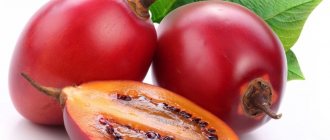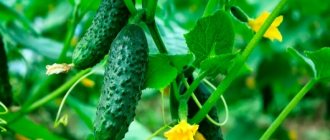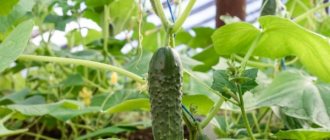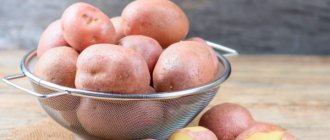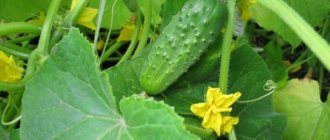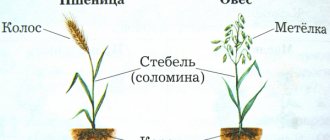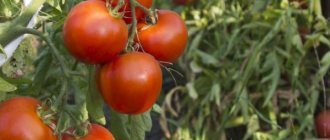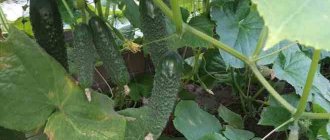Botanical description
Cucumber is the oldest plant known to mankind since ancient times. The vegetable is native to Western India, from where it has spread throughout the world. This is one of the few crops consumed by humans in their unripe form. Due to this feature, the plant was nicknamed “aguros”, which translated from Greek means “unripe”.
Cucumbers are characterized by a taproot with a large number of lateral shoots. The stem of young seedlings is smooth, erect, while those of flowering and fruiting ones are rough, creeping, ending in branched tendrils (for climbing vertical supports). Moreover, the central shoot of the plant forms many lateral vines, from which vines of the second, third and fourth orders extend. At the same time, the number of secondary offspring depends on the variety of cucumbers and the growing conditions of the crop. The length of the main stem varies from 1 to 3 m, and the lateral branches from 0.3 to 0.8 m. The leaves of the vegetable are petiolate, heart-shaped, alternately located on creeping vines. As the stem grows, yellow funnel-shaped flowers with jagged edges form in the axils of the rudimentary plates. The stamens of cucumbers are fused in pairs, and the ovary, protruding, is pubescent along its entire length. The buds contain special glands that release fragrant nectar into the air.
Interestingly, bee-pollinated cucumbers are monoecious dioecious plants that produce both female and male flowers. Moreover, their staminate corollas contain sticky pollen, and their pistillate corollas contain ovaries with three- or four-lobed stigmas. Moreover, the number of male buds significantly exceeds the number of female ones. These plants require cross-pollination to bear fruit.
Monoecious plants are suitable for cultivation only in open ground. This is due to the fact that in greenhouse conditions it is impossible to ensure proper pollination. Breeders managed to solve this problem by developing parthenocarpic forms of cucumbers that form ovaries without the participation of insects.
The outer surface of the vegetable can be either smooth, spiky or coarsely tuberous. Moreover, the size, shape, color of the “pubescence” and the structure of the peel directly depend on the plant variety.
Cucumber sizes
The size of the cucumber depends on the variety of this crop. There is a generally accepted state standard that specifies the sizes of various varieties and hybrids of cucumbers in accordance with their purposes. Fruits are divided into the following sizes:
- short-fruited group I - no more than 11 cm;
- short-fruited group II - no more than 14 cm;
- medium-fruited and long-fruited - no more than 25 cm.
For pickles, small cucumbers with the following sizes are used:
- pickles - 3-5 cm;
- gherkins of group I - 5.1-7 cm;
- gherkins of group II - 7.1-9 cm;
- greens - no more than 11 cm.
Note! Overgrown fruits are not used for preservation. They are used for salads; when completely yellowed, they are used as feed for livestock and poultry.
When pickling, housewives often wonder how much a medium-sized cucumber weighs, since recipes often mention quantity, not weight. It is generally accepted that the average weight of this vegetable is 70-90 g.
Preservation in jars
Chemical composition
Cucumber is a valuable low-calorie product (14 kcal per 100 g).
The vitamin component of the vegetable is not very expressive. Most of the ingredient composition is water (95%), which contains a natural adsorbent that absorbs and removes poisons from the body. This is a natural cleansing substance with a spectrum of action similar to activated carbon. Table No. 1 “Nutritional value of cucumber”
| Name | Concentration in 100 grams of raw materials, grams |
| Water | 95 |
| Carbohydrates | 2,5 |
| Mono- and disaccharides | 2,5 |
| Alimentary fiber | 1,0 |
| Squirrels | 0,8 |
| Ash | 0,5 |
| Pectin | 0,4 |
| Organic acids (tartaric, lactic) | 0,1 |
| Starch | 0,1 |
| Fats | 0,1 |
Table No. 2 “Chemical composition of cucumber”
| Name | Concentration in 100 grams of vegetable, milligram |
| Vitamins | |
| Ascorbic acid (C) | 10 |
| Pantothenic acid (B5) | 0,27 |
| Niacin (B3) | 0,2 |
| Alpha tocopherol (E) | 0,1 |
| Pyridoxine (B6) | 0,04 |
| Riboflavin (B2) | 0,04 |
| Thiamine (B1) | 0,03 |
| Beta carotene (A) | 0,005 |
| Folic acid (B9) | 0,004 |
| Biotin (H) | 0,0009 |
| Macronutrients | |
| Potassium | 141 |
| Phosphorus | 42 |
| Chlorine | 25 |
| Calcium | 23 |
| Magnesium | 14 |
| Sodium | 8 |
| Microelements | |
| Zinc | 0,22 |
| Manganese | 0,18 |
| Iron | 0,6 |
| Copper | 0,1 |
| Fluorine | 0,017 |
| Chromium | 0,006 |
| Iodine | 0,003 |
| Cobalt | 0,001 |
| Molybdenum | 0,001 |
Table No. 3 “Amino acid composition of cucumber”
| Name | Concentration in 100 grams of product, grams |
| Glutamic acid | 0,14 |
| Arginine | 0,05 |
| Aspartic acid | 0,05 |
| Leucine | 0,03 |
| Serin | 0,03 |
| Glycine | 0,03 |
| Valin | 0,03 |
| Lysine | 0,03 |
| Phenylalanine | 0,02 |
| Proline | 0,02 |
| Isoleucine | 0,02 |
| Threonine | 0,02 |
| Tyrosine | 0,02 |
| Histidine | 0,01 |
| Methionine | 0,01 |
| Tryptophan | 0,01 |
In addition to water, vitamins, minerals, carbohydrates, proteins and fiber, cucumbers contain polyphenols (secoisolariciresinol, lariciresinol, pinoresinol), which have an oncoprotective effect on the body.
Interestingly, on the island of Fiji, vegetables are considered the most valuable product, indicating human well-being. For example, the bride's parents do not consent to their daughter's marriage until the groom presents them with supplies of cucumbers.
Interesting facts about cucumbers
- There is more vitamin C in small cucumbers, and as they ripen and increase in size, the amount of this nutrient decreases. Yes, yes, this “citrus” vitamin is also there!

